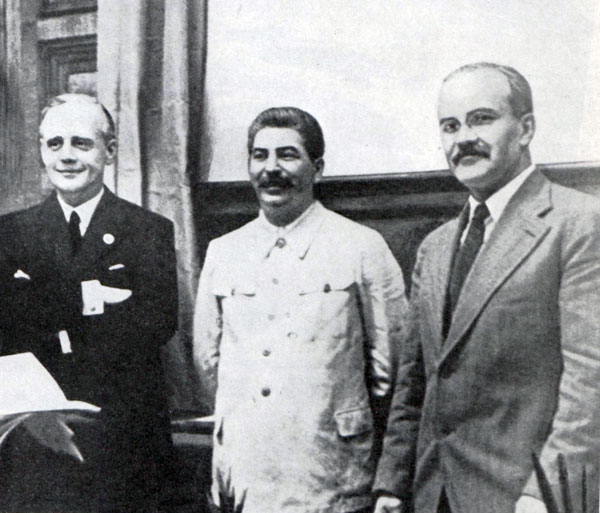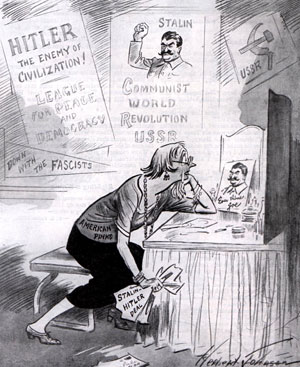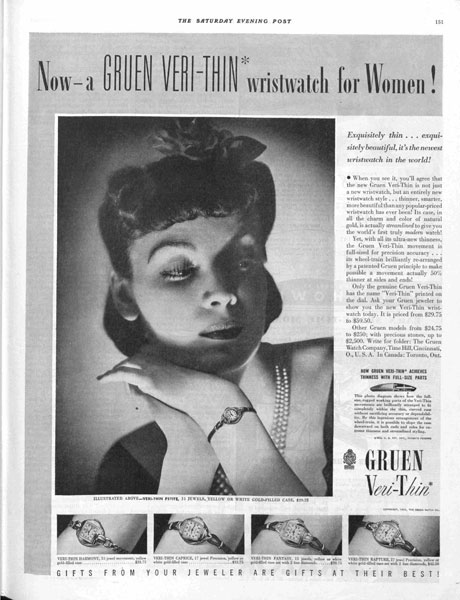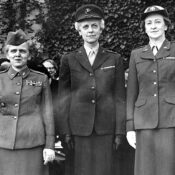
The week before news of the war stunned America, the country had been shocked by an even more startling piece of news. On August 23, 1939, Nazi Germany and Soviet Russia — the two most dedicated foes in Europe — became allies.
For years, they had each shaped their foreign policies around total opposition to each other. Hitler and Stalin had both built fanatical support among their people by demonizing each other. Now, under the Molotov-Ribbentrop Pact, the two men would be the political equivalent to friends.
Both dictators had good reasons for making the deal. It would allow Hitler to invade Poland without fearing an unexpected attack from Russia. And it would give Stalin more time to build up his military. Germany sweetened the deal by allowing Stalin to grab up the independent Baltic nations of Estonia, Latvia, and Lithuania. Hitler even invited Stalin to divide the spoils of a defeated Poland.

As Post journalist Demaree Bess saw it, the agreement between these two dictators led to World War II just as surely as the shooting of Franz Ferdinand led to World War I. He wrote, “Joseph Stalin shares equal responsibility with Adolf Hitler for plunging Europe into war.”
The agreement kicked the legs out from under the world’s radicals. Ever since 1917, when the Bolsheviks had overthrown Russia’s autocratic government, revolutionaries around the world had viewed the new communist government as the future of mankind. When the First World War ended and Europe’s governments tried to turn back the clock to regain privilege and power for their ruling classes, Russia seemed to be the only progressive force on the continent. The radical regarded the Soviet Union, not the U.S., as the international champion of liberty. To them, Lenin replaced Lincoln as the great emancipator. And Russia’s commitment to world communism, they believed, would end the oppression of workers everywhere.
Of course much of this thinking was put forth by the Soviet government itself. It had sent agents around the globe to promote unrest, destabilize governments, and recruit activists who would help establish the dictatorship of the proletariat. Men and women by the thousands gave their efforts, and sometimes their lives, to realize this dream. But the Worker’s Paradise in communist Russia had become a cruel joke, particularly after Stalin seized total power. The Soviet government had become the regime of a despot.
Communist supporters recognized Stalin could be ruthless and cruel, but most remained faithful to the revolution. A few of them hoped to rise to power in Stalin’s new world order. But most avoided looking closely at the Soviet’s violent excesses: independent farmers destroyed, thousands of opponents executed, and millions of Ukrainian peasants starved to death. Communism, these supporters argued, had to be ruthless, violent, and deceptive if it was going to defeat the forces of reaction.
By the late 1930s, though, it was getting harder to keep faith with Soviet Russia. News was leaking out of the country, despite rigid censorship, that Stalin had executed not only his opponents but thousands of his most dedicated followers.
And then Stalin signed a peace accord with his sworn enemy. For many radicals who still supported the ideals of communism, this was simply too much. Stalin had betrayed them.

“Heartbroken”
Herbert Johnson cartoon appeared in the Post in 1939 illustrated communist supporters’ disillusionment with the Molotov-Ribbentrop Pact.
“By his deal with the Nazis,” Bess wrote, “Stalin completely wrecked the Communist movement in all countries except his own. He finally made it clear, even to the most muddleheaded liberals, that there is little or nothing to choose between Stalin and Hitler, between Bolshevism and Nazism. He deliberately threw away any prospect of world leadership which he might have possessed.
“The Russian revolution … ceased to become an expansive world force on the day Stalin announced his deal with Hitler,” he continued. “The antics of the Bolsheviks, from this time onward, are of concern only to the people of Russia and their immediate prey. The tragedy is that Communism’s collapse as a world movement was achieved only by provoking European war.”
With his pact signed, Hitler invaded Poland within the week. Seventeen days later, Stalin followed suit. He sent his army into eastern Poland, violating a nonaggression pact he had signed with that country six years earlier. Stalin’s disregard of his old treaty with Poland didn’t phase Hitler. He wasn’t relying on the Soviet leader to keep his word, anyway. The Nazi leader was planning to break the Molotov-Ribbentrop Pact when it suited him.
That moment came the morning of June 22, 1941, when he sent his troops across the Russian border, racing away to deliver the final blow to communism. When he first heard of Hitler’s plan, Stalin refused to believe it. He had the officer who reported the German invasion executed. But gradually, doubt gave way to certainty. Stalin hurriedly retreated to his country home, refusing to talk to anyone, fearful that his misjudgment of Hitler would earn him the punishment he had meted out to so many old Communist Party members.
Yet he survived Hitler’s betrayal. And thousands of hard-core communists survived Stalin’s betrayal of communist principles. By the time the war ended, the communist machinery for world domination was up and running, ready to swallow Eastern Europe and much of Asia.
Step into 1939 with a peek at these pages from The Saturday Evening Post 75 years ago:
Become a Saturday Evening Post member and enjoy unlimited access. Subscribe now









Comments
This doesn’t talk at all about after World War II how many Americans became disillusioned with communism